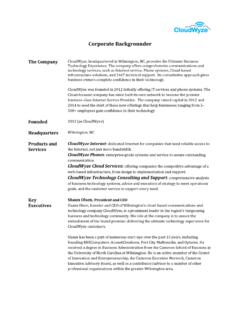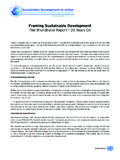Transcription of Will removing GST on fresh fruit and vegetables achieve ...
1 1 Will removing GST on fresh fruit and vegetables achieve its stated aim? Child Poverty Action Group (Inc) backgrounder 01/10 December 2010 2 Child Poverty Action Group (Inc) (CPAG) is a non-profit group formed in 1994, and made up of academics, activists, practitioners and supporters. CPAG has a strong education and research role which enables it to contribute to better informed social policy to support children in Aotearoa New Zealand, specifically children who live in poverty. CPAG believes that our high rate of child poverty is not the result of economic necessity, but is due to policy neglect and a flawed ideological emphasis on economic incentives. Through research, CPAG highlights the position of tens of thousands of New Zealand children, and promotes public policies that address the underlying causes of the poverty they live in. If you are not already supporting CPAG and you would like to make a donation to assist with ongoing work, please contact us at the address below or through our website: This is part of Child Poverty Action Group s series of Background Papers.
2 Disclaimer: This publication is intended to provide accurate and adequate information on the matters contained herein and every effort has been made to ensure its accuracy. However, it has been written, edited and published and made available to all persons and entities strictly on the basis that its author, editors and publishers are fully excluded from any liability or responsibility by all or any of them in any way to any person or entity for anything done or omitted to be done by any person or entity in reliance, whether totally or partially, on the contents of this publication for any purpose whatsoever. December 2010 Child Poverty Action Group Inc. P. O. Box 56 150 3 CPAG considers it would be much less costly overall and more beneficial to address the lack of purchasing power of low income families than to attempt to make good food more affordable by a selective application of GST.
3 In addition to the high administration costs such a policy imposes on both the IRD and the retailer, taking GST off fresh fruit and vegetables is likely to benefit high-income families the most and the revenue cost of such a policy requires extra taxes elsewhere or spending cuts that may harm low-income households more. The recent increase in goods and services tax (GST) from up to 15% has produced much concern about the way in which low-income people are affected. Early in 2010, the Maori Party s Rahui Katene put forward a private members bill that would have exempted healthy food from GST, and on the 27th of September 2010 Labour announced that it will remove GST from fresh fruit and vegetables if it wins the next Reasons for removing GST off particular foodstuffs vary but tend to fall under two main headings: improving affordability for struggling families that currently find it difficult to afford good quality, healthy food; and an incentive effect that encourages people to eat more fresh fruit and vegetables to the benefit of their health.
4 There is little doubt that improving food affordability for low-income households and eating more healthily are worthwhile goals in themselves. The question is, will removing GST on fresh fruit and vegetables achieve them? Before answering that, we need to consider what removing GST would mean in practice. At present New Zealand s GST captures everything except housing, rents and financial transactions, all of which can be ignored for our purposes. This universal application brings numerous administrative benefits for both IRD and businesses processing GST returns. Also, organisations do not waste time trying to squeeze their service or product into a GST-exempt category to gain a competitive price advantage. The broad coverage of GST also implies that it is an economically efficient tax relative to other countries consumption taxes. Indeed it allows the New Zealand government to collect a relatively large proportion of its tax revenue from GST levied at a comparatively low rate.
5 In 2009 1 The aim of simplifying the category of healthy food via the label fresh has resulted in Labour ignoring the high nutritional content and low cost of frozen fruit and vegetables . 4 GST revenue accounted for 21% of the government s tax revenue2 despite being levied at a rate of only , the sixth lowest in the The trade-off is that GST is regressive. Because it is an across-the-board tax, everyone pays the same GST on a carton of milk; low-income households pay more GST as a proportion of their income than higher income households. The heart of the proposal to remove GST from fruit and vegetables is that it will make GST less regressive . Yet he 2003 Children s Nutrition Survey4 found that children in low-income families ate less fruit and vegetables than children in high-income households. Recent research done for the Families Commission5 also found that low-income households ate fewer fruit and vegetables , and that buying more would be difficult on their current budgets.
6 Moreover, junk food is significantly cheaper than healthy food, including fresh fruits and vegetables , and the Auckland Regional Public Health Service6 has shown that junk food outlets are more likely to be found in low-decile Suppose a family with a weekly food budget of $100 currently spends $25 on fresh fruit and vegetables . The GST content of that purchase of fresh fruit and vegetables is currently $ Assuming that the price of fruit and vegetables decreases to the full extent of the GST reduction such that the bundle of $25 of fruit and vegetables now costs $ , then the family has the extra $ purchasing power a week. It should not be assumed this extra $ may not be spent on more fresh fruit and vegetables . It may in fact be used to purchase highly processed, less healthy food. As a result, the desired benefits to the family s health may not result. The problem therefore is not the absolute price of fresh fruit and vegetables , it s that even with GST exemptions the relative price difference between healthy food and less healthy food means many households will continue to purchase less healthy food.
7 Further, there is evidence that people on low incomes tend to purchase calorie dense foods with the money they have available. These foods are high in fat, and often highly processed with little or no nutritional value. This is a major contributor to obesity and overweight in low-income people because they, quite rationally, buy as many calories as they can for their 2 The New Zealand Treasury. (2009a). Challenges and Choices, New Zealand's Long-term Fiscal Statement. Wellington: The New Zealand Treasury. Retrieved from 3 White, D. (2009). A Tax System for New Zealand's Future: Morning Session 2 GST Symposium conducted at the meeting of the A Tax System for New Zealand's Future, The Centre for Accounting, Governance and Taxation Research, Victoria University,. Retrieved from 4 Ministry of Health. 2003. NZ Food NZ Children: Key Results of the 2002 National Children's Nutrition Survey. Wellington: Ministry of Health.
8 5 Smith, C., Parnell, W., & Brown, R. (2010). Family Food Environment: Barriers to Acquiring Affordable and Nutritious Food in New Zealand Households. Wellington: Families Commission Blue Skies Report 32/10. 6 Auckland Regional Public Health Service. 2006. Improving Health and Well-being: A Public Health Perspective for Local Authorities in the Auckland Region. Auckland: Auckland Regional Public Health Service. 7 Here junk means highly processed food that is high in some combination of fat, salt and sugar. 5 Junk food may have little nutritional value, but nutrition is not the foremost objective when low-income families are struggling to feed their children. For all its good intentions removing GST off fresh fruit and vegetables fails to address the important issue of socioeconomic inequality. GST can only be re-distributive to the extent that it taxes more highly goods consumed by high-income households. As shown above, fresh fruit and vegetables are more likely to be consumed by high-income households and thus exempting those products from GST may in fact further contribute to socioeconomic inequality.
9 Moreover, high-income households have more capacity to change their expenditure patterns away from more heavily taxed goods towards lower taxed A relative inability to avoid GST means low-income households may be adversely affected by the exemptions. In addition, obesity rates are higher in countries with high rates of income inequality as measured by the Gini The graph below plots obesity rates of OECD countries against their Gini The trend line shows that there is a correlation ( ) between income inequality and obesity. (Note this is only obesity, not obese and overweight.) 8 Drewnowski, A, and N Darmon. 2005. The Economics of Obesity: Dietary Energy Density and Energy Cost. American Journal of Clinical Nutrition 82(suppl):265S-273S. 9 Creedy, J. (2001). Indirect Tax Reform and the Role of Exemptions. Fiscal Studies, 22(4), 457-486. Retrieved from 10 The Gini coefficient is a measure of income inequality.
10 I is perfect inequality, 0 is perfect equality. Most OECD countries have a Gini coefficient of , with higher numbers being more unequal. 11 Two outliers have been taken out: Japan because with an obesity rate of about 3% it is well outside the normal OECD range, and diet is a big factor; and Turkey because it exhibits a Gini coefficient that is more consistent with a developing economy. 6 Food is more than just fuel, it is also a comfort and a treat. People on low incomes are more likely to be stressed, and for them junk food that is engineered to taste good is stress relief, and perhaps even be an affordable luxury. Until we attend to issues of low absolute levels of income that encourage the purchase of cheap bad food, and high levels of income inequality that are correlated with high levels of stress and associated overweight and obesity, then it makes more sense to continue to collect the GST on fruit and vegetables , maintain the simplicity and efficiency of the tax, and use the revenue for something socially useful.



